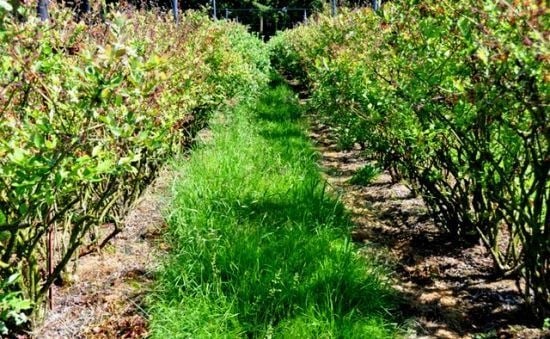New and Emerging Viruses of Blueberry and Cranberry
Abstract
:1. Introduction
2. Nepoviruses—Nematode and/or Pollen-Borne
2.1. Blueberry Latent Spherical Virus
2.1.1. Blueberry Leaf Mottle Virus
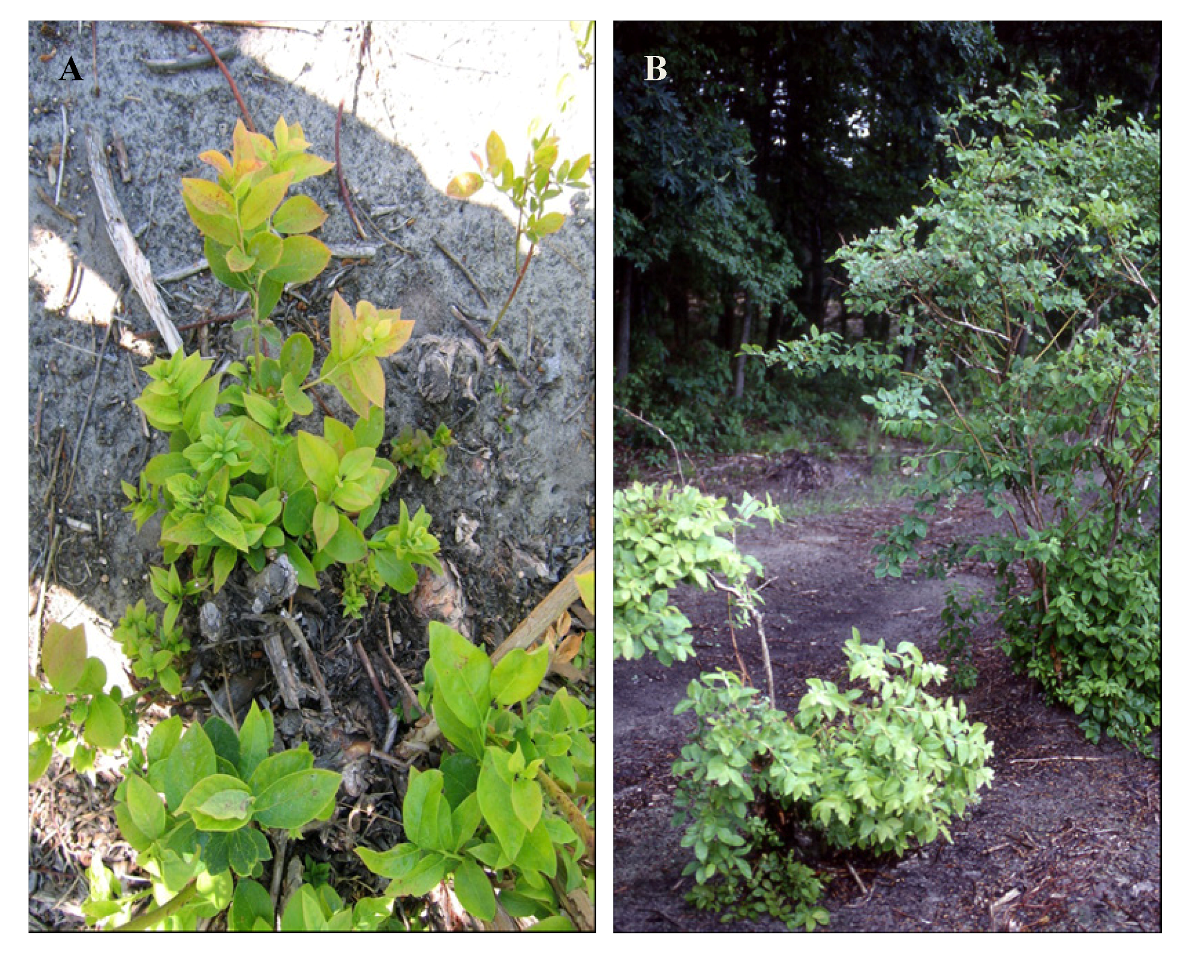
2.1.2. Peach Rosette Mosaic Virus
2.2. Necrotic Ringspot Disease [Tobacco Ringspot Virus (TRSV) and Tomato Ringspot Virus (ToRSV)]

3. Ilarviruses—Pollen-Borne
3.1. Blueberry Shock Virus (BlShV)

3.2. Tobacco Streak Virus
4. Aphid-Borne
4.1. Blueberry Scorch Virus
4.2. Blueberry Shoestring Virus
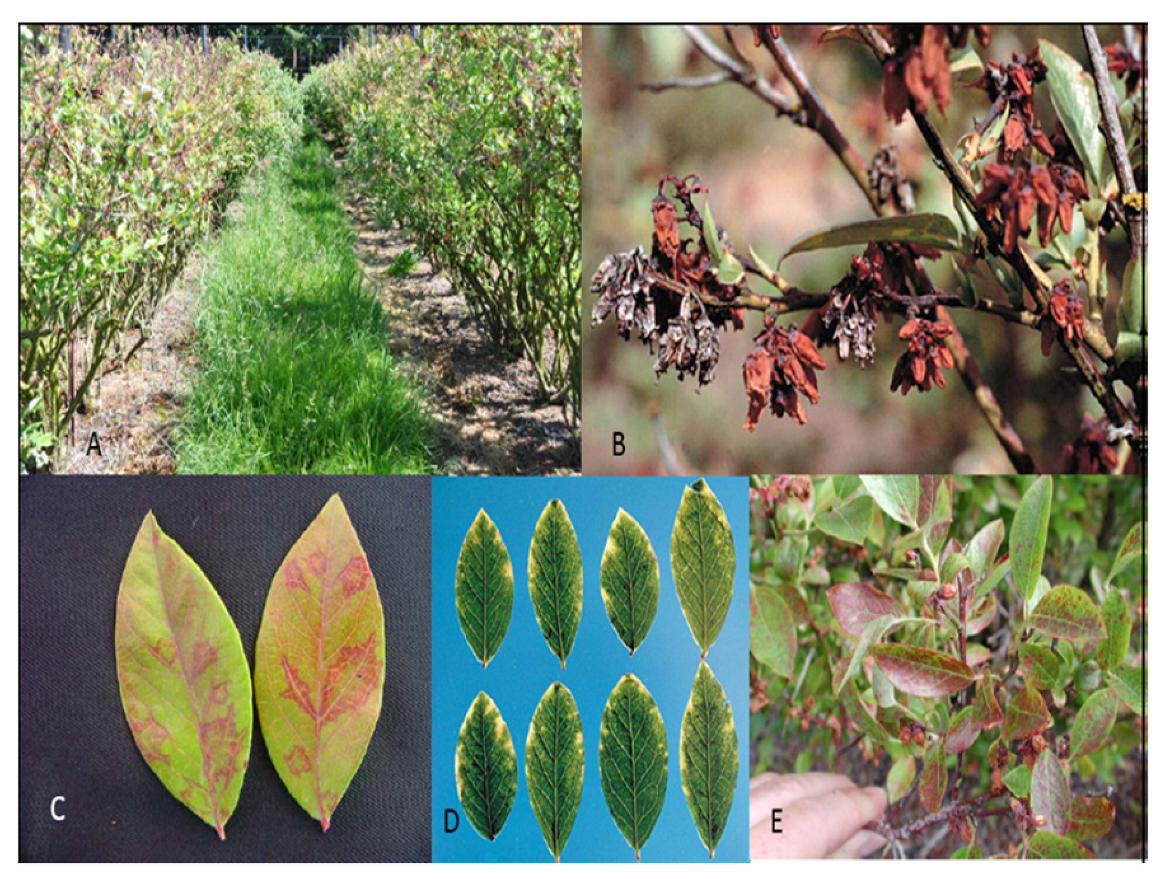
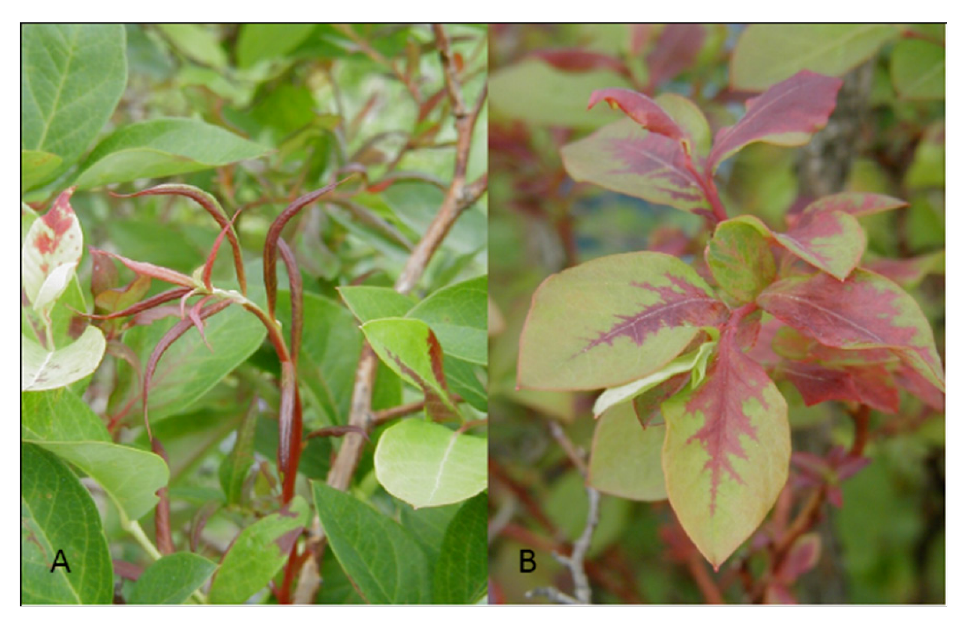
5. Vector Unknown
5.1. Blueberry Latent Virus
5.2. Blueberry Mosaic Virus
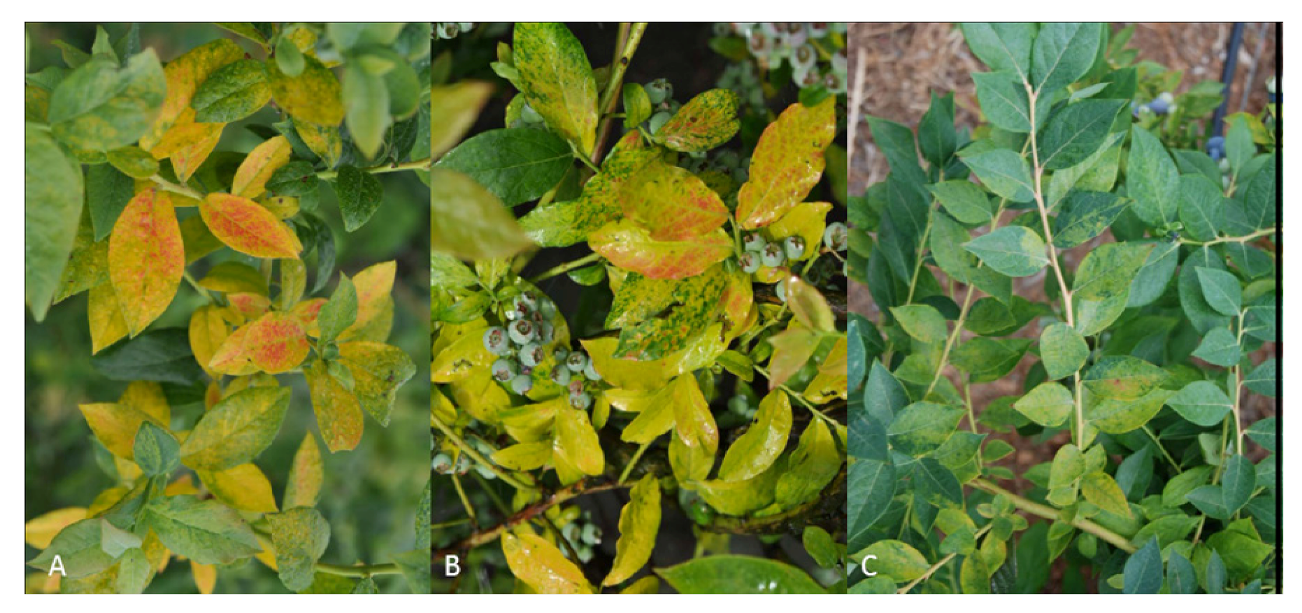
5.3. Blueberry Necrotic Ring Blotch Virus
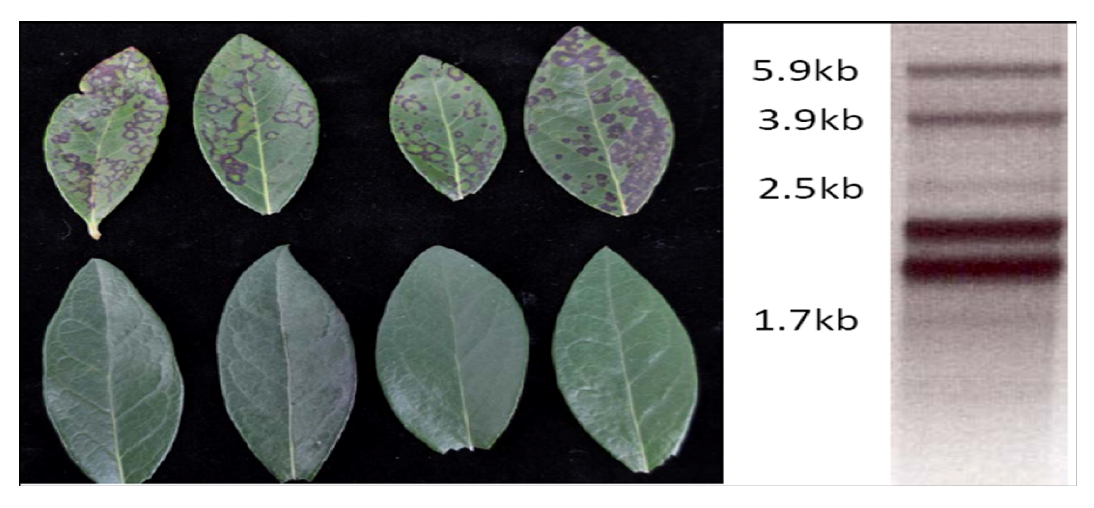
Blueberry Red Ringspot Virus

5.4. Blueberry Virus A
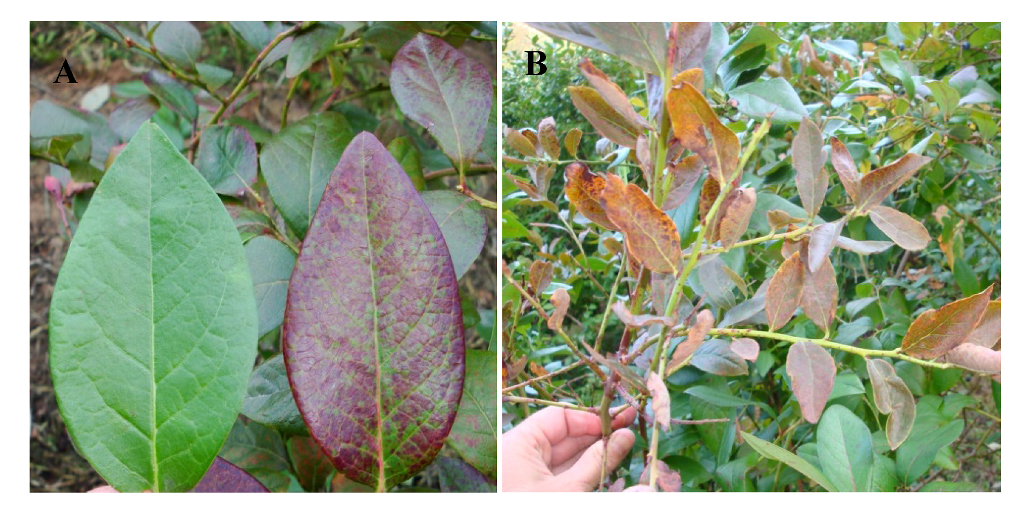
6. Conclusions
Acknowledgments
Conflict of Interest
References and Notes
- Walters, D.R.; Keil, D.J. Ericaceae. In Vascular Plant Taxonomy, 4th ed; Kendal/Hunt Publishing Company: Dubuque, IA, USA, 1996; pp. 340–343. [Google Scholar]
- Cho, E.; Seddon, J.M.; Rosner, B.; Willett, W.C.; Hankinson, S.C. Prospective study of intake of fruits, vegetables, vitamins, and carotenoids and risk of age-related maculopathy. Arch. Ophthalmol. 2004, 122, 883–892. [Google Scholar] [CrossRef]
- Kalt, W.; Howell, A.B.; MacKinnon, S.L.; Goldman, I.L. Selected bioactivities of Vaccinium berries and other fruit crops in relation to their phenolic contents. J. Sci. Food Agric. 2007, 87, 2279–2285. [Google Scholar] [CrossRef]
- Rimando, A.M.; Nagmani, R.; Feller, D.R.; Yokoyama, W. Pterostilbene, a newagonist for the peroxisome proliferator-activated receptor a-isoform, lowers plasma lipoproteins and cholesterol in hypercholesterolemic hamsters. J. Agric. Food Chem. 2005, 53, 3403–3407. [Google Scholar] [CrossRef]
- Villata, M. Trends in world blueberry production. Available online: http://www.growingproduce.com/article/26272/trends-in-world-blueberry-production/ (accessed on 31 August 2012).
- Oudemans, P.V.; Caruso, F.; Stretch, A. Cranberry fruit rot in the Northeast: A complex disease. Plant Dis. 1998, 82, 1176–1184. [Google Scholar] [CrossRef]
- Martin, R.R.; Tzanetakis, I.E.; Caruso, F.L.; Polashock, J.J. Emerging and reemerging virus diseases of blueberry and cranberry. Acta Hortic. 2009, 810, 299–304. [Google Scholar]
- Isogai, M.; Tatuto, N.; Ujiie, C.; Watanabe, M.; Yoshikawa, N. Identification and characterization of blueberry latent spherical virus, a new member of subgroup C in the genus Nepovirus. Arch. Virol. 2012, 157, 297–303. [Google Scholar] [CrossRef]
- Jaswal, A.S. Occurrence of blueberry leaf mottle, blueberry shoestring-, tomato ringspot and tobacco ringspot viruses in eleven halfhigh blueberry clones grown in New Brunswick, Canada. Can. Plant Dis. Surv. 1990, 70, 113–117. [Google Scholar]
- Martin, R.R.; Tzanetakis, I.E. USDA-ARS, Corvallis, OR, USA and University of Arkansas, Fayetteville, AR, USA. Unpublished data, 2011.
- Ramsdell, D.C.; Stace-Smith, R. Blueberry leaf mottle, a new disease of highbush blueberry. Acta Hortic. 1979, 95, 37–45. [Google Scholar]
- Sandoval, C.R.; Ramsdell, D.C.; Hancock, J.F. Infection of wild and cultivated Vaccinium spp. with blueberry leaf mottle nepovirus. Ann. Appl. Biol. 1995, 126, 457–464. [Google Scholar] [CrossRef]
- Ramsdell, D.C.; Stace-Smith, R. Physical and chemical properties of the particles and ribonucleic acid of blueberry leaf mottle virus. Phytopathology 1981, 71, 468–472. [Google Scholar]
- Bacher, J.W.; Warkentin, D.; Ramsdell, D.; Hancock, J.F. Sequence analysis of the 3' termini of RNA1 and RNA2 of blueberry leaf mottle virus. Virus Res. 1994, 33, 145–156. [Google Scholar] [CrossRef]
- Sanfaçon, H.; Iwanami, T.; Karasev, A.V.; van der Vlugt, R.; Wellink, J.; Wetzel, T.; Yoshikawa, N. Secoviridae. In Virus Taxonomy, Ninth Report of the International Committee on Taxonomy of Viruses; King, A.M.Q., Adams, M.J., Carstens, E.B., Lefkowitz, E.J., Eds.; Academic Press: San Diego, CA, USA, 2011; pp. 881–899. [Google Scholar]
- Childress, A.M.; Ramsdell, D.C. Bee-mediated transmission of blueberry leaf mottle virus via infected pollen in highbush blueberry. Phytopathology 1987, 77, 167–172. [Google Scholar] [CrossRef]
- Elbeaino, T.; Digiaro, M.; Fallanaj, F.; Kuzmanovic, S.; Martelli, G.P. Complete nucleotide sequence and genome organisation of grapevine Bulgarian latent virus. Arch. Virol. 2011, 156, 875–879. [Google Scholar] [CrossRef]
- Hildebrand, E.M. A new case of rosette mosaic of peach. Phytopathology 1941, 31, 353–355. [Google Scholar]
- Dias, H.F.; Cation, D. The characterization of a virus responsible for peach rosette mosaic and grape decline in Michigan. Can. J. Bot. 1976, 54, 1228–1239. [Google Scholar]
- Ramsdell, D.C.; Gillet, J.M. Reach rosette mosaic virus in highbush blueberry. Plant Dis. 1981, 65, 755–758. [Google Scholar]
- Lammers, A.H.; Allison, R.F.; Ramsdell, D.C. Cloning and sequencing of peach rosette mosaic virus RNA 1. Virus Res. 1999, 65, 57–73. [Google Scholar] [CrossRef]
- Eveleigh, E.S.; Allen, W.R. Description of Longidorus diadecturus n.sp. (Nematoda: Longidoridae), a vector of the peach rosette mosaic virus in peach orchards in southwestern Ontario, Canada. Can. J. Zool. 1982, 60, 112–115. [Google Scholar] [CrossRef]
- Klos, E.J.; Fronec, F.; Knierim, J.M.; Cation, D. Peach rosette mosaic transmission and control studies. Mich. Agric. Exp. Station Q. Bull. 1967, 49, 287–293. [Google Scholar]
- Awad, M.A.E.; Ibrahem, L.M.; Aboul-Ata, A.E.; Ziedan, M.; Mazyad, H.M.; Abdel-Aziz, E.; Mansour, N. Virus-free plum and peach mother plant production in Egypt. Acta Hortic. 1998, 472, 531–536. [Google Scholar]
- Azerý, T.; Çýçek, Y. Detection of virus diseases affecting almond nursery trees in Western Anatolia (Turkey). EPPO Bull. 1997, 27, 547–550. [Google Scholar] [CrossRef]
- Varney, E.H.; Raniere, L.C. Necrotic ringspot, a new virus disease of cultivated blueberry. Phytopathology 1960, 50, 241. [Google Scholar]
- Lister, R.M.; Raniere, L.C.; Varney, E.H. Relationships of viruses associated with ringspot diseases of blueberry. Phytopathology 1963, 53, 1031–1035. [Google Scholar]
- Caruso, F.L.; Ramsdell, D.C. Compendium of Blueberry and Cranberry Diseases; APS Press: St. Paul, MN, USA, 1995; p. 87. [Google Scholar]
- Fuchs, M.; Abawi, G.S.; Marsella-Herrick, P.; Cox, R.; Cox, K.D.; Carroll, J.E.; Martin, R.R. Occurrence of Tomato ringspot virus and Tobacco ringspot virus in highbush blueberry in New York State. J. Plant Pathol. 2010, 92, 451–459. [Google Scholar]
- Medina, C.; Matus, J.T.; Zúñiga, M.; San-Martin, C.; Arce-Johnson, P. Occurrence and distribution of viruses in commercial plantings of Rubus, Ribes and Vaccinium species in Chile. Cienc. Investig. Agrar. 2006, 33, 23–28. [Google Scholar]
- Tzanetakis, I.E. University of Arkansas, Fayetteville, AR, USA. Unpublished data, 2010.
- Pinkerton, J.N.; Martin, R.R. Management of Tomato ringspot virus in red raspberry with crop rotation. Int. J. Fruit Sci. 2005, 5, 55–67. [Google Scholar] [CrossRef]
- MacDonald, S.G.; Martin, R.R.; Bristow, P.R. Characterization of an ilarvirus associated with a necrotic shock reaction in blueberry. Phytopathology 1991, 81, 210–214. [Google Scholar] [CrossRef]
- Bristow, P.R.; Windom, G.E.; Martin, R.R. Recovery of plants infected with Blueberry shock virus (BlShV). Acta Hortic. 2002, 574, 85–89. [Google Scholar]
- Bristow, P.R.; Martin, R.R. Transmission and the role of honeybees in field spread of Blueberry shock ilarvirus, a pollen borne virus of highbush blueberry. Phytopathology 1999, 89, 124–130. [Google Scholar] [CrossRef]
- Martin, R.R. USDA-ARS, Corvallis, OR, USA. Unpublished data, 2011.
- Schilder, A. Blueberry shock virus, Pest Alert Factsheet. Michigan State University Extension, East Lansing, MI, USA, 2009.
- Jones, A.T.; McGavin, W.J.; Dolan, A. Detection of Tobacco streak virus isolates in North American cranberry (Vaccinium macrocarpon Ait.). Plant Health Progr. 2011. [Google Scholar]
- Vorsa, N. Rutgers University, Chatsworth, NJ, USA. Personal communication, 2012.
- Sdoodee, R.; Teakle, D.S. Transmission of tobacco streak virus by Thrips tabaci a new method of plant virus transmission. Plant Pathol. 1987, 36, 377–380. [Google Scholar] [CrossRef]
- Stretch, A.W. A previously undescribed blight disease of highbush blueberry in New Jersey. Phytopathology 1983, 73, 375. [Google Scholar]
- Bristow, P.R.; Martin, R.R. A virus associated with a new blight disease of highbush blueberry. Phytopathology 1987, 77, 1721–1722. [Google Scholar]
- Podleckis, E.V.; Davia, R.F.; Stretch, A.W.; Schulz, C.P. Flexuous rod particles associated with Sheep Pen Hill Disease of highbush blueberries. Phytopathology 1986, 76, 1065. [Google Scholar]
- Martin, R.R.; Bristow, P.R. A Carlavirus associated with blueberry scorch disease. Phytopathology 1988, 78, 1636–1640. [Google Scholar]
- Martin, R.R.; MacDonald, S.G.; Podleckis, E.V. Relationships between blueberry scorch and Sheep Pen Hill viruses of highbush blueberry. Acta Hortic. 1992, 308, 131–139. [Google Scholar]
- Podleckis, E.V.; Davis, R.F. Infection of highbush blueberries with a putative carlarvirus. Acta Hortic. 1989, 241, 338–343. [Google Scholar]
- Bernardy, M.G.; Dubeau, C.R.; Braun, A.; Harlton, C.E.; Bunckle, A.; Lowery, D.T.; French, C.J.; Wegener, L. Molecular characterization and phylogenetic analysis of two distinct strains of Blueberry scorch virus from western Canada. Can. J. Plant Pathol. 2005, 27, 581–591. [Google Scholar] [CrossRef]
- Cavileer, T.D.; Halpern, B.T.; Lawrence, D.M.; Podleckis, E.V.; Martin, R.R.; Hillman, B.I. Nucleotide sequence of the carlavirus associated with blueberry scorch and similar diseases. J. Gen. Virol. 1994, 75, 711–720. [Google Scholar]
- Martin, R.R.; Bristow, P.R.; Wegener, L.A. Scorch and Shock: Emerging virus diseases of highbush blueberry and other Vaccinium spp. Acta Hortic. 2006, 715, 463–467. [Google Scholar]
- Richert-Pöggeler, K.R.; Turhal, A.K.; Schuhmann, S.; Maaß, C.; Blockus, S.; Zimmermann, E.; Eastwell, K.C.; Martin, R.R.; Lockhart, B. Carlavirus biodiversity in horticultural host plants: Efficient virus detection and identification combining electron microscopy and molecular biology tools. Acta Hortic. 2013, in press.. [Google Scholar]
- Ciuffo, M.; Pettiti, D.; Gallo, S.; Masenga, V.; Turina, M. First report of Blueberry scorch virus in Europe. Plant Pathol. 2005, 54, 565. [Google Scholar] [CrossRef]
- Bristow, P.R.; Martin, R.R.; Windom, G.E. Transmission, field spread, cultivar response, and impact on yield in highbush blueberry infected with blueberry scorch virus. Phytopathology 2000, 90, 474–479. [Google Scholar] [CrossRef]
- Wegener, L.A.; Punja, Z.K.; Martin, R.R. First Report of Blueberry scorch virus in cranberry in Canada and the United States. Plant Dis. 2004, 88, 427. [Google Scholar]
- Wegener, L.A.; Punja, Z.K.; Martin, R.R. First Report of Blueberry scorch virus in black huckleberry in British Columbia. Plant Dis. 2007, 91, 328. [Google Scholar]
- Lowery, D.T.; French, C.J.; Bernardy, M. Nicotiana occidentalis: A new herbaceous host for Blueberry scorch virus. Plant Dis. 2005, 89, 205. [Google Scholar]
- Lawrence, D.M.; Hillman, B.I. Synthesis of infectious transcripts of blueberry scorch carlavirus in vitro. J. Gen. Virol. 1994, 75, 2509–2512. [Google Scholar] [CrossRef]
- Oudemans, P.V.; Hillman, B.I.; Linder-Basso, D.; Polashock, J.J. Visual inspections of nursery stock fail to protect new plantings from Blueberry scorch virus infection. Crop Prot. 2011, 30, 871–875. [Google Scholar] [CrossRef]
- Ramsdell, D.C. Physical and chemical properties of Blueberry shoestring virus. Phytopathology 1979, 69, 1087–1091. [Google Scholar]
- Varney, E.H. Mosaic and shoestring virus diseases of cultivated blueberry in New Jersey. Phytopathology 1957, 47, 307–309. [Google Scholar]
- Ramsdell, D.C. Blueberry Shoestring. In Virus Diseases of Small Fruits; Converse, R.H., Ed.; US Department of Agriculture, Agriculture Handbook No. 631, US Government Printing Office: Washington, D.C., USA, 1987; pp. 103–105. [Google Scholar]
- Lesney, M.S.; Ramsdell, D.C.; Sun, M. Etiology of blueberry shoestring disease and some properties of the causal virus. Phytopathology 1978, 68, 295–300. [Google Scholar]
- Truve, E.; Fargette, D. Sobemovirus. In Virus Taxonomy, Ninth Report of the International Committee on Taxonomy of Viruses; King, A.M.Q., Adams, M.J., Carstens, E.B., Lefkowitz, E.J., Eds.; Academic Press: San Diego, CA, USA, 2011; pp. 1185–1189. [Google Scholar]
- Morimoto, K.M.; Ramsdell, D.C.; Gillett, J.M.; Chaney, W.G. Acquisition and transmission of Blueberry shoestring virus by its aphid vector Illinoia pepperi. Phytopathology 1985, 75, 709–712. [Google Scholar] [CrossRef]
- Acquaah, T.; Ramsdell, D.C.; Hancock, J.F. Resistance to blueberry shoestring virus in southern highbush and rabbiteye cultivars. HortScience 1995, 30, 1459–1460. [Google Scholar]
- Martin, R.R.; Tzanetakis, I.E.; Sweeney, M.; Wegener, L. A virus associated with blueberry fruit drop disease. Acta Hortic. 2006, 715, 497–501. [Google Scholar]
- Martin, R.R.; Zhou, J.; Tzanetakis, I.E. Blueberry latent virus: An amalgam of the Partitiviridae and the Totiviridae. Virus Res. 2011, 155, 175–180. [Google Scholar] [CrossRef]
- Sabanadzovic, S.; Valverde, R.A.; Brown, J.K.; Martin, R.R.; Tzanetakis, I.E. Southern tomato virus: The link between the families Totiviridae and Partitiviridae. Virus Res. 2009, 140, 130–137. [Google Scholar] [CrossRef]
- Isogai, M.; Nakamura, T.; Ishii, K.; Watanabe, M.; Yamagishi, N.; Yoshikawa, N. Histochemical detection of Blueberry latent virus in highbush blueberry plant. J. Gen. Plant Pathol. 2012, 77, 304–306. [Google Scholar]
- Ramsdell, D.C.; Stretch, A.W. Blueberry Mosaic. In Virus Diseases of Small Fruits; Converse, R.H., Ed.; US Department of Agriculture, Agriculture Handbook No. 631: Washington, D.C., USA, 1987; pp. 119–120. [Google Scholar]
- Martin, R.R. USDA-ARS, Corvallis, OR, USA. Unpublished data, 2012.
- Tzanetakis, I.E.; Martin, R.R. University of Arkansas, Fayetteville, AR, USA and USDA-ARS, Corvallis, OR, USA. Unpublished data, 2012.
- Zhu, S.F.; Gillet, J.M.; Ramsdell, D.C.; Hadidi, A. Isolation and characterization of viroid-like RNAs from mosaic diseased blueberry tissue. Acta Hortic. 1995, 385, 132–140. [Google Scholar]
- Thekke-Veetil, T.; Martin, R.R.; Tzanetakis, I.E. University of Arkansas, Fayetteville, AR, USA (T.-V.T. and T.I.E.) and USDA-ARS, Corvallis, OR, USA (M.R.R.). Unpublished data, 2012.
- Vaira, A.M.; Gago-Zachert, S.; Garcia, M.L.; Guerri, J.; Hammond, J.; Milne, R.G.; Moreno, P.; Morikawa, T.; Natsuaki, T.; Navarro, J.A.; et al. Ophiovirus. In Virus Taxonomy, Ninth Report of the International Committee on Taxonomy of Viruses; King, A.M.Q., Adams, M.J., Carstens, E.B., Lefkowitz, E.J., Eds.; Academic Press: San Diego, CA, USA, 2011; pp. 743–748. [Google Scholar]
- Martin, R.R. USDA-ARS, Corvallis, OR, USA. Personal observations, 2006.
- Quito-Avila, D.F.; Martin, R.R. Blueberry necrotic ring blotch virus represents a unique genus of plant RNA viruses. Phytopathology 2012, 102, S4.96. [Google Scholar]
- Burkle, C.; Olmstead, J.W.; Harmon, P.F. A potential vector of Blueberry necrotic ring blotch virus and symptoms on various host genotypes. Phytopathology 2012, 102, S4.17. [Google Scholar]
- Robinson, T.S.; Brannen, P.M.; Deom, C.M. Blueberry necrotic ring blotch: A new disorder of southern highbush blueberries. Phytopathology 2012, 102, S4.101. [Google Scholar]
- Hutchinson, M.T.; Varney, E.H. Ringspot—A virus disease of cultivated blueberry. Plant Dis. Rep. 1954, 38, 260–262. [Google Scholar]
- Cline, W.O.; Ballington, J.R.; Polashock, J.J. Blueberry red ringspot observations and findings in North Carolina. Acta Hortic. 2009, 810, 305–312. [Google Scholar]
- Gillett, J.M. Physical and chemical properties of blueberry red ringspot virus.
- Boone, D.M. Ringspot disease of cranberry. Plant Dis. Rep. 1966, 50, 543–545. [Google Scholar]
- Glasheen, B.M.; Polashock, J.J.; Lawrence, D.M.; Gillett, J.M.; Ramsdell, D.C.; Vorsa, N.; Hillman, B.I. Cloning, sequencing, and promoter identification of Blueberry red ringspot virus, a member of the family Caulimoviridae with similarities to the “Soybean chlorotic mottle-like” genus. Arch. Virol. 2001, 147, 2169–2186. [Google Scholar]
- Polashock, J.J.; Ehlenfeldt, M.K.; Crouch, J.A. Molecular detection and discrimination of blueberry red ringspot virus strains causing disease in cultivated blueberry and cranberry. Plant Dis. 2009, 93, 727–733. [Google Scholar]
- Isogai, K.; Ishii, M.; Umemoto, S.; Watanabe, M.; Yoshikawa, N. First report of blueberry red ringspot disease caused by Blueberry red ringspot virus in Japan. J. Gen. Plant Pathol. 2009, 75, 140–143. [Google Scholar] [CrossRef]
- Cho, I.S.; Chung, B.N.; Cho, J.D.; Choi, G.S. First report of Blueberry red ringspot virus infecting highbush blueberry in Korea. Plant Dis. 2012, 96, 1074. [Google Scholar]
- Kalinowska, E.; Paduch-Cichal, E.; Chodorska, M.; Sala-Rejczak, K. First report of Blueberry red ringspot virus in highbush blueberry in Poland. J. Plant Pathol. 2011, 93, S4.73. [Google Scholar]
- Pleško, I.M.; Marn, M.V.; Koron, D. Detection of Blueberry red ringspot virus in highbush blueberry cv. 'Coville' in Slovenia. Julius-Kuhn-Archives 2010, 427, 204–205. [Google Scholar]
- Přibylová, J.; Špak, J.; Kubelková, D.; Petrzik, K. First Report of Blueberry red ringspot virus in Highbush Blueberry in the Czech Republic. Plant Dis. 2010, 94, 1071. [Google Scholar]
- Schilder, A.C. Michigan State University, East Lansing, MI, USA. Personal communication, 2009.
- Martin, R.R.; Schilder, A.C. USDA-ARS, Corvallis, OR, USA and Michigan State University, East Lansing, MI, USA. Unpublished data, 2011.
- Isogai, M. Iwate University, Morioka, Iwate, Japan. Personal communication, 2012.
- Welliver, R.A. Plum pox virus case study: The eradication road is paved in gold. Phytopathology2012, 102, S4.154.
© 2012 by the authors; licensee MDPI, Basel, Switzerland. This article is an open-access article distributed under the terms and conditions of the Creative Commons Attribution license (http://creativecommons.org/licenses/by/3.0/).
Share and Cite
Martin, R.R.; Polashock, J.J.; Tzanetakis, I.E. New and Emerging Viruses of Blueberry and Cranberry. Viruses 2012, 4, 2831-2852. https://doi.org/10.3390/v4112831
Martin RR, Polashock JJ, Tzanetakis IE. New and Emerging Viruses of Blueberry and Cranberry. Viruses. 2012; 4(11):2831-2852. https://doi.org/10.3390/v4112831
Chicago/Turabian StyleMartin, Robert R., James J. Polashock, and Ioannis E. Tzanetakis. 2012. "New and Emerging Viruses of Blueberry and Cranberry" Viruses 4, no. 11: 2831-2852. https://doi.org/10.3390/v4112831
APA StyleMartin, R. R., Polashock, J. J., & Tzanetakis, I. E. (2012). New and Emerging Viruses of Blueberry and Cranberry. Viruses, 4(11), 2831-2852. https://doi.org/10.3390/v4112831




